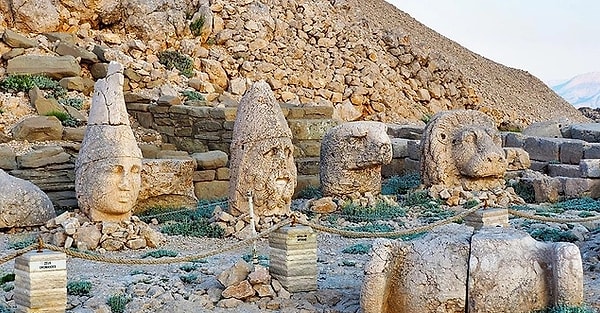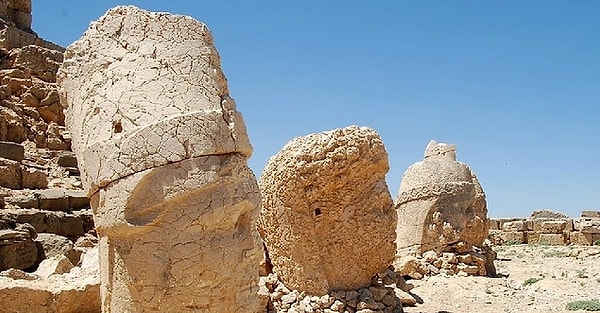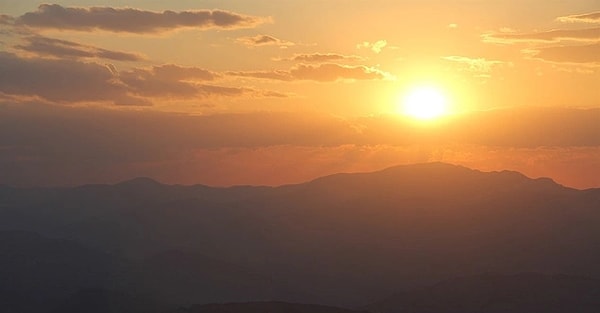Mount Nemrut Travel Guide: Discover Nemrut's Story, Sculptures and Importance
Although Commagene is mostly associated with raw meatballs (chee kofta) today, it is actually a historical kingdom that bears the traces of a rich civilisation with deep roots dating back thousands of years. Mount Nemrut, located between Adıyaman and Malatya, stands out as one of the most remarkable and magnificent legacies of this ancient civilisation. This impressive mountain, which is culturally significant to both Adıyaman and Malatya, fascinates its visitors with its monumental statues on its summit and mesmerising sunrise and sunset views. When travelling to Nemrut, it is important to dress appropriately for the season, choose comfortable walking shoes and meet your food and beverage needs in advance.
So, what are the details that make Mount Nemrut so special and impressive? How to visit Mount Nemrut?
About Mount Nemrut

Mount Nemrut is located 2150 meters above sea level. This region, where the Commagene Kingdom ruled in the 1st century BC, still preserves its mystery with its gigantic statues. This unique mountain near Kayadibi Village in Adıyaman's Kahta district is the religious and cultural centre of the Commagene Kingdom.
The Discovery of the Statues

At Mount Nemrut, we often encounter giant head statues standing on the ground. However, only the heads of these statues have survived to the present day; their bodies have been destroyed over time. The statues are located on the east and west terraces, one facing the sunrise and the other facing the sunset. These monumental structures, carved entirely from limestone blocks, bear witness to thousands of years of history.
The first person to introduce Nemrut to the world was Karl Sester, a German engineer working on road construction in Diyarbakır. Sester reported his findings to the Royal Academy, believing the site to belong to the Assyrians. As a result, a team of archaeologists led by Otto Punchstein was sent to the region. Through their research, they deciphered an inscription written in Greek, determining that the site belonged to the Kingdom of Commagene and Antiochus I. The inscription contains texts written in Antiochus' own words and plays a key role in unravelling the region's mysteries.
In later periods, Osman Hamdi Bey, founder of the Istanbul Archaeology Museum, and German engineer Karl Humann also participated in the excavations. Between 1953 and the 1980s, extensive archaeological studies were conducted by American archaeologist Theresa Goell and Friedrich Karl Dörner. While the portable artefacts are exhibited in various museums, the statues and inscriptions still await visitors at Mount Nemrut today.
Mount Nemrut was added to the UNESCO World Heritage List in 1987 and was declared a National Park in 1989, thus coming under protection.
The Meaning of the Statues

The purpose of the giant head statues on Mount Nemrut is interpreted as bringing together different cultures and beliefs under a common roof. Archaeological data shows that these statues symbolise the gods of the period.
The Kingdom of Commagene was a civilisation heavily influenced by Persian and Hellenistic cultures. This led to both Persian and Greek elements being incorporated into the kingdom's mythological and religious understanding. Queen Laodice, a descendant of Alexander the Great, and King Antiochus I Theos, son of King Mithridates I, were raised in this synthesised culture. In order to keep his people united, he had statues built to symbolise that he was appointed and protected by the gods, and had temples built all over the kingdom.
King Mithridates I developed a vision of cultural synthesis in order to expand his kingdom. His son Antiochus I, who inherited this idea, built a temple on Mount Nemrut and erected giant statues representing the gods, some as tall as 10 metres, in this sacred area. Although the dream of uniting the two cultures did not fully come to fruition, thanks to this vision, we still witness a fascinating legacy today. Mount Nemrut and its surroundings, with traces of the Commagene Kingdom, have transformed the Kahta district of Adıyaman into an attractive tourist destination.
At an altitude of 2,150 metres, this mountain combines ancient statues, unique sunrise and sunset views, and the magic of nature.
The Statues

The statues of gods, which have become the symbol of Nemrut, are located on two terraces, east and west. In the centre of both terraces rises the tumulus believed to be the tomb of Antiochos I. The best preserved part today is the east terrace. Although not much remains of the temple, statue bodies and heads are exhibited in the area.
The statues are arranged from right to left as Lion, Eagle, Antiochos, Commagene, Zeus, Apollo and Heracles. In 2002, the heads of the statues were placed in front of the bodies they belonged to and arranged in order. It was measured that the size of these statues reached 8-9 metres. How these structures were built at that time is still a mystery.
The Guardian Statues

The Lion and Eagle statues at the beginning and end of the statue rows are known as guardian figures. However, only one pair of protective statues can be seen today.
Eagle: It symbolises the sovereignty of the Commagene Kingdom in the sky. It is also considered the sacred animal that carries the orders of Zeus to the people.
Lion: It represents the power and dominance of the kingdom on earth.
God Statues

King Antiochos (Theos): Antiochos wanted to be remembered with the gods after his death, so he had his own statue made. The statue holds a bundle of branches in his hand. The head could not be found in the first discoveries and was unearthed from under the gravel in 1953.
Commagene: The only female figure among the gods. Pomegranate and grape motifs symbolising fertility are on her head. The head of the statue remained on its pedestal for a long time, but it was separated like the other heads as a result of a lightning strike in 1963.
Zeus: The statue of Zeus, the greatest of the gods, is placed in the centre of the array and is larger than the other statues. Zeus has a Persian tiara on his head and is bearded, although his chin appears broken.
Apollo: Apollo, the symbol of light and wisdom, follows Zeus. He also carries a branch in his hand.
Heracles: The son of Zeus and Alkmene, a mortal, Heracles is at the end of the line of gods. He represents the struggle of man against nature. He holds a stick in his hand and has a beard.
Tumulus: The tumulus on Mount Nemrut is a mound believed to be the tomb of Antiochos I. It was built by piling approximately 30,000 m³ of crushed stone. The reason why it was built at the highest point of the region was to be closer to the gods. The tomb has not yet been reached because it is thought that the whole structure was designed to collapse if it were entered.
Where is Mount Nemrut?

Address: Nemrut Mountain Road, 02000 Kayadibi/Kâhta/Adıyaman
Visiting Hours: Open 24/7
Visitor Comment:
'You need to go at sunrise or sunset. The view is wonderful at these times. You can go up to a certain point by car, then you need to walk uphill for about 15 minutes. The sculptures are really interesting, a must-see. It is unique in terms of cultural heritage.'
How to get to Mount Nemrut?

Transportation by Air
After landing at Gaziantep Airport, you can reach Adıyaman by renting a car or by bus. You can go to the Kahta district from Adıyaman and benefit from guidance and transport services. Alternatively, you can also plan by following the flights to Adıyaman Airport.
By Bus
You can take a minibus from Adıyaman Bus Terminal to the Kahta district. You can get a guide and vehicle service to go to Nemrut from Kahta.
Travelling by Private Car
The distance between Istanbul and Kahta is approximately 1260 km and it will take approximately 15 hours.
Those coming from Ankara can follow the Kırıkkale, Kayseri-Pınarbaşı and Malatya roads to Adıyaman and from there to Kahta.
As an alternative route, you can use the Gaziantep motorway and reach Kahta via Gaziantep - Şanlıurfa.
Keşfet ile ziyaret ettiğin tüm kategorileri tek akışta gör!

Send Comment